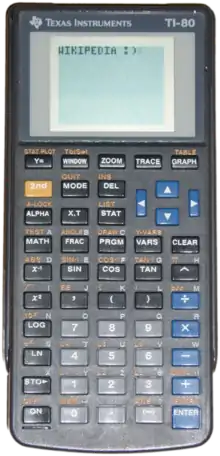TI-80
The TI-80 is a graphing calculator designed by Texas Instruments in 1995 to be used at a middle school level (grades 6-8).
 | |
| Type | Graphing calculator |
|---|---|
| Manufacturer | Texas Instruments |
| Introduced | 1995 |
| Discontinued | 1998 |
| Successor | TI-73 series |
| Calculator | |
| Entry mode | D.A.L. |
| Precision | 13 |
| Display size | 64×48 pixels, 16×8 characters |
| CPU | |
| Processor | Proprietary (on board a Toshiba T6M53 or T6M53A ASIC) |
| Frequency | 980 kHz |
| Programming | |
| User memory | 7 KB of RAM |
| Other | |
| Power supply | 2 CR2032 batteries |
| Weight | 106 grams (3.7 oz) |
| Dimensions | 163 mm × 71 mm × 15 mm (6.4 in × 2.8 in × 0.60 in) |
The TI-80 featured a 48 x 64 dot-matrix display with a 5 x 3 pixel font, the smallest screen of any TI graphing calculator. It had the slowest processor (980 kHz) of any TI graphing calculator. The first revision of the TI-80 'A' contained a proprietary Toshiba T6M53 ASIC while subsequent revisions contained a Toshiba T6M53A. Additionally, the TI-80 had the processor on board the ASIC, unlike later calculators like the TI-83, TI-83 Plus, and TI-84 Plus which had separate ASIC and processor chips in certain models. In comparison, the TI-81, released in 1990, featured a 2 MHz Zilog Z80 processor. However, the TI-80 did feature 7 KB of RAM (compared with the TI-81's 2.4 KB). The TI-80 also had more built-in functions than the TI-81 (such as list and table functions, as well as fraction and decimal conversions). Like the TI-81, the TI-80 did not feature a link port on the base model, however, unlike the TI-81, the ViewScreen variant (meant for use with TI's overhead projection units) did. The TI-80 was the only graphing calculator to use 2 CR2032 lithium batteries (instead of the standard 4 AAA batteries with a lithium backup battery).
Since its release, it has been superseded by the superior TI-73 and TI-73 Explorer. The TI-80 was officially discontinued in 1998, when it was replaced by the TI-73, however, production continued until at least October 2000.